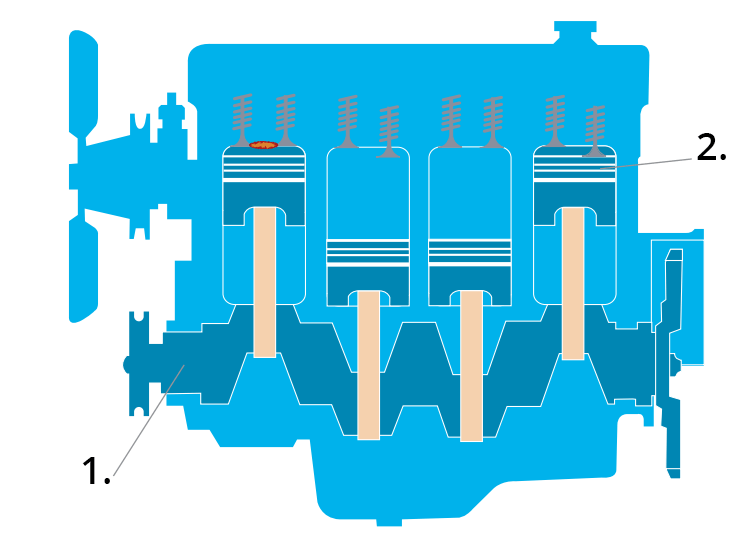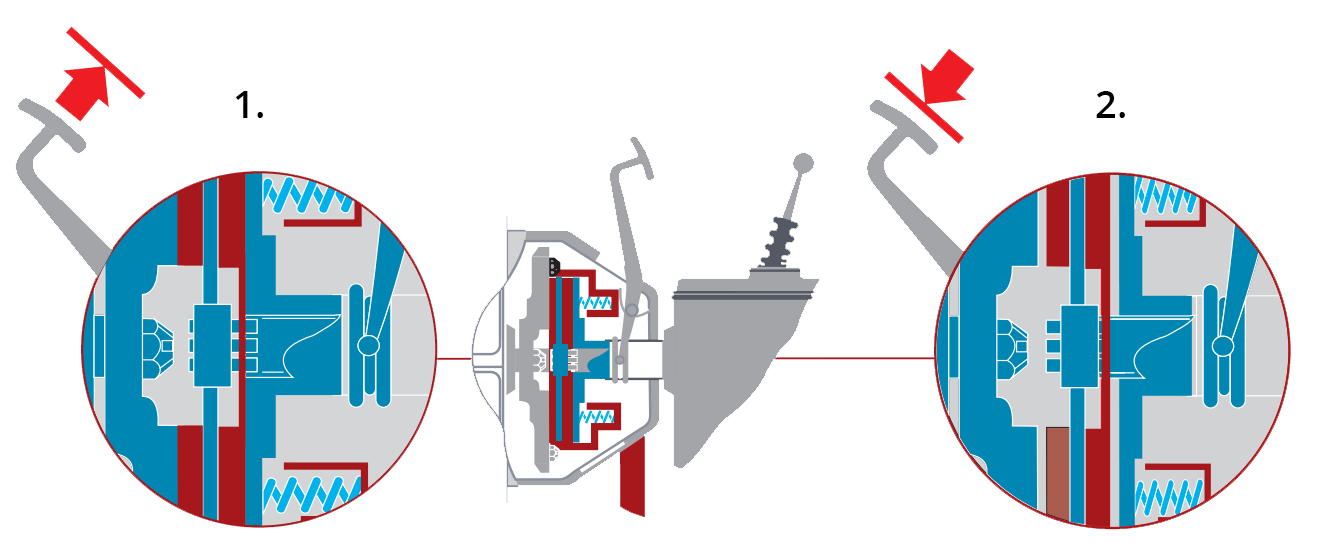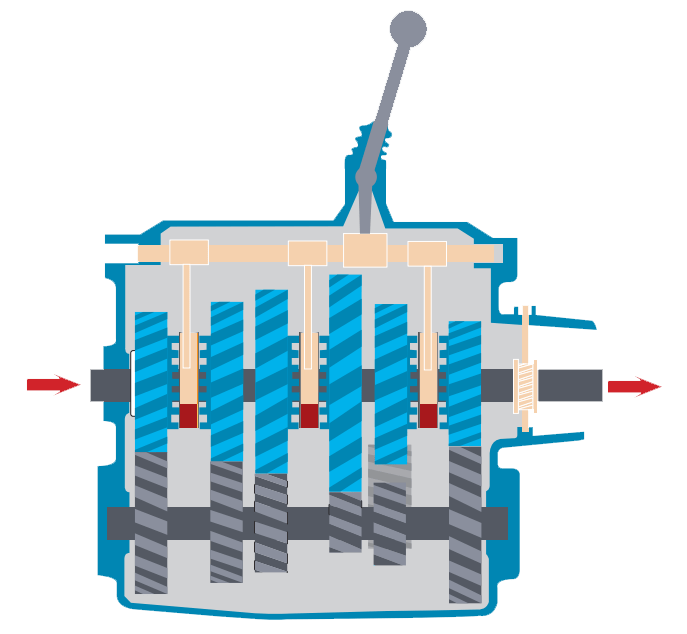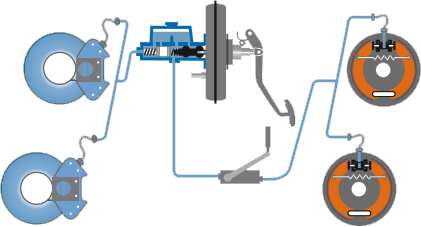Passenger car
Driving school
theory book
to category B
- Sections 1.1 - 1.3: Furnishings, equipment and documents.
- Engine, ignition and accelerator
- Engine and exhaust system
- Clutch
- Gear and gearbox
- The board of directors
- Driver and owner responsibilities
- Brakeman
- Lights, reflectors and horns
- Load-bearing parts
- Tyres and shock absorbers
- Bodywork
- Specialised equipment
- Specialised vehicles
- Energy and environmentally friendly driving
- Test your knowledge
- Cat. B - Sections 1.1 - 1.3
Sections 1.1 - 1.3: Furnishings, equipment and documents.
How the car works.
After you've read this section, you'll be driving in a closed practice area. There, your instructor will show you the most important aspects of the car's layout and equipment. From steering wheel and lights to pedals, gears and seat belts. You probably already know these things, but as a driver you also need to know what functions they have and what demands are placed on them. Your driving instructor will explain this to you.
Instruments and indicator lights.
As new cars are equipped with a number of warning lights and warning devices, it is important that you thoroughly familiarise yourself with the meaning of these. It's also important that you familiarise yourself with where to top up oil, coolant, sprinkler fluid, etc.
But before you get out on the driving range and try these things, you need to know how the car works. You'll learn that in this section, and fortunately, you don't need to be a mechanic to understand it. But it's important knowledge. If you have it, it's easier for you to drive and treat your car right.
Engine, ignition and accelerator
The engine's job is simply to make the car run. But how? First, turn the ignition key all the way to the right. As soon as the engine has started, release the key so as not to damage the starter ring. The starter motor, which is powered by a battery, starts the car's "real" engine.
Cars run primarily on petrol or diesel. In petrol engines, petrol is ignited by sparks from spark plugs, and in diesel engines, diesel oil is self-ignited due to high pressure. What both types of fuel have in common is that when mixed with air, sent into the engine and ignited, it triggers pistons that move up and down.
The pistons are connected to a rotating crankshaft, converting their movement into rotational motion. It is this motion that is transmitted via the clutch and gears to the driving wheels of the car. On most cars, the front wheels are the driving wheels. This is called a front-wheel drive car.
Engine and exhaust system
There are some risk factors that you need to be aware of. These include:
- If the exhaust system is leaking or if you drive with the tailgate open, for example, there is a risk of inhaling the exhaust gas, which contains carbon monoxide. It's toxic and odourless, so you really need to be careful!
- There is a risk of damaging a catalytic converter if you fill your car with leaded petrol. In addition, you should never park a car with a catalytic converter over dry grass, withered leaves or similar. The catalytic converter is very hot after driving and can ignite a fire. Attempting to push or drag the car can damage the catalytic converter.
- Too little oil on the engine or too little water in the cooling system will damage the engine.
Faults can occur in the engine or exhaust system. You can recognise the most typical faults in this way:
- Black exhaust smoke often means poor combustion due to engine faults or a clogged air filter.
- Unusual noise when you press the accelerator indicates a faulty muffler.
- If you step on the accelerator and hear the engine revs increase without the car's speed increasing, there may be a fault in the clutch.
- If it's difficult to shift gears or if it's very noisy, there may be a fault in the gearbox or clutch.
- If the car moves forward slowly in 1st gear even though the clutch pedal is depressed, this indicates a fault in the clutch.
You must be able to identify or verify the following:
- The engine does not produce unnecessary smoke and noise.
- The engine is not dirty from oil leaks.
- The exhaust system is tight and secure.
- Sufficient engine oil has been filled, as indicated by the dipstick's max. and min. marks on the dipstick or according to the instructions in the manual.
- Sufficient coolant has been added according to the instructions in the user manual.
- Filler cap for oil and cooling water.
Clutch
The clutch transfers the movement of the engine to the gearbox. The clutch works by connecting a plate to the rotating flywheel that sits on the end of the crankshaft in the engine. This transfers the motion to the gearbox.
When you press the clutch pedal all the way down, you disconnect the connection between the engine and the gearbox. You need to do this when changing gear or coming to a stop, for example. But it's also a good idea to depress the clutch pedal before starting the engine.
When you need to get your car moving, you need to find the clutch point, which is where the engine and gearbox are reconnected. This can be a little tricky. Lift the clutch pedal slowly when starting in 1st gear to avoid the car jumping forwards or stalling. On cars with hydraulics for the clutch, make sure there is enough fluid in the clutch.
Gear and gearbox
The gears are used to maximise the engine's revolutions. You probably recognise this from a bike with gears. If you choose a low gear, you can start, ride slowly or climb a steep hill more easily. If you choose a higher gear, it's usually because you're travelling faster. In other words, you choose your gear depending on the type of driving you do. As you know, reverse gear is the gear you need to select to make the car go backwards.
In the gearbox, the clutch is connected to the drive wheels. The gearbox consists of several sets of intermeshing gears. One cog is connected to the clutch, the other is connected to the drive wheels. The size of the gears depends on which gear you are driving in. You adjust this with the gear lever. This way you can control how the engine's movements are transferred to the wheels.
The board of directors
The steering system is designed so that when you turn the steering wheel, the front wheels turn with it. In almost all cars, the steering wheel turns automatically to the straight-ahead position, for example, after you have turned a corner. This is called self-levelling steering. Newer cars have power steering, which makes it easier to turn the steering wheel. If a car with power steering seems "heavy", it could be because it's lacking fluid. You can see this in the power steering fluid reservoir. It could also be that the drive belt is broken or worn. The power steering can also be electrical and faults in this system will also cause the steering to feel "heavy". If the wheels do not immediately follow the steering wheel's movements, it could be a sign of play in the steering connections. In this case, the steering system should be inspected. Newer cars are equipped with Electronic Stability Control (ESC), which can prevent rollover and skidding by braking one or more wheels.
Driver and owner responsibilities
§ If you are the owner or registered user of a car, it is your responsibility to ensure that it fulfils the legal requirements.
As the driver, you are responsible for ensuring that the car is in a safe condition.
Pay particular attention to the car's steering, brakes, lights and horn, the engine and exhaust system, as well as the vehicle's load-bearing parts. If you are travelling with a trailer, the driver must check that the coupling is secure.
The driver of a motorised vehicle shall at all times be aware of the legal condition of the vehicle with regard to the noise emissions of the vehicle and with regard to the conditions of the vehicle's engine and the vehicle's pollution control devices that affect the emission of air pollutants from the motorised vehicle.

You may find that the car turns in a sharper or softer curve than it should, in relation to the movement of the steering wheel. This is called oversteer and understeer respectively. The tendency is exacerbated if the tyre pressure or loading is incorrect.
You must be able to identify or verify the following:
There should normally be no wheel play. You can check this by having the wheels immediately follow the movement of the steering wheel (in cars with power steering, the check is done with the engine running).
If your car has a power steering reservoir, the fluid level must follow the car manufacturer's instructions. You can check this either by ensuring that the fluid level is between the min. and max. mark, or that the indicator light is not lit.
Possibly an oil filler cap for the power steering.
Brakeman
There's no doubt about why your car's brakes need to work. When you step on the brake pedal, you press a piston in the brake system's main cylinder. This creates fluid pressure. This fluid pressure is then transferred through brake pipes and hoses to the brakes, where a brake pad is pressed against a drum or disc to brake the wheels.
When you brake, the car doesn't stop immediately. The distance the car travels from when you start braking until it comes to a complete stop is called the braking distance. The braking distance depends on how fast you drive and how hard you brake, among other things.
Newer cars have ABS brakes, which are anti-lock brakes. You can't steer the car if the wheels lock. With ABS brakes, it is theoretically possible to steer and brake at the same time because the wheels do not lock, even when braking very hard.
The electronic sensor is located at the wheels, where it detects wheel rotations and sends pulses to an electronic control box. If you brake and there is a tendency for one or more wheels to lock, the electronic control box will regulate the pressure to the brakes. If this happens, you will feel a vibration in the brake pedal.
The parking brake (handbrake) acts on the wheel brakes through special connections and must be designed so that it can remain applied. The parking brake can be electrically operated.
The service brake (foot brake) is equipped with a brake booster that amplifies the pressure created in the brake system when you press the brake pedal. If the brake booster fails, it may be unsafe and illegal to continue driving.
There are two types of wheel brakes: drum brakes and disc brakes.
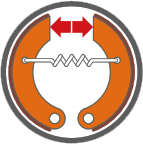
The drum brake is so named because the brake lining is pressed against a drum.
The disc brake gets its name because two brake pads are pressed together against a disc that sits on the hub of the wheel.
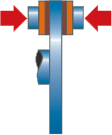
Most cars have disc brakes on the front wheels and drum brakes on the rear wheels.
A dual-circuit braking system is designed so that if one system fails, the other acts as an emergency braking system. It is reckless and illegal to continue driving if one brake system fails.
It's not just for the driving test that these things need to be in order. If you as a driver realise that these things are not working, the car needs to be towed to a workshop.
You need to be aware of the faults that can occur in the brakes. If your car pulls unevenly when you brake lightly on a flat road, the brake pads may be dirty or damp. When you wash your car, some water may seep onto the brake pads, but this will disappear when you brake. Make a small braking manoeuvre before heading out into traffic. You may also experience uneven braking or wheel chatter. This can be caused by faulty brake drums, discs or pads.
If the brake pedal can suddenly be depressed further than usual, this is a sign that one of the brake circuits is defective. Finally, if the indicator light for the ABS brakes does not go out shortly after starting the car, something is wrong and only driving to the nearest workshop is allowed.
You need to be able to verify that:
- It must not be possible to depress the brake pedal when the pedal is pressed hard. Pedal travel is also dependent on the make of car
- The brake pedal feels firm and doesn't sink when you hold it down with constant pressure as the car has vacuum boosted brakes, the brake pedal sinks slightly when you hold it down and start the engine
- The brake fluid level is between the min. and max. marks, or the brake fluid level indicator light is not lit.
§ The law says about the brakes that:
- The service brake must work on all wheels. It must be effective, fast and safe at all speeds and loads
- The parking brake must be able to keep the car stopped on an inclined road
- The emergency brake (parking brake or one circuit in a two-circuit braking system) must be able to safely stop the car if the service brake suddenly fails.
Lights, reflectors and horns
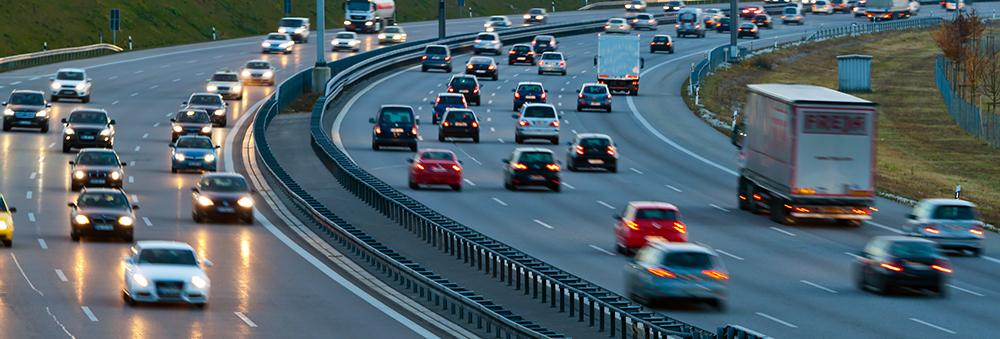
The light in the headlights should be white or yellowish.
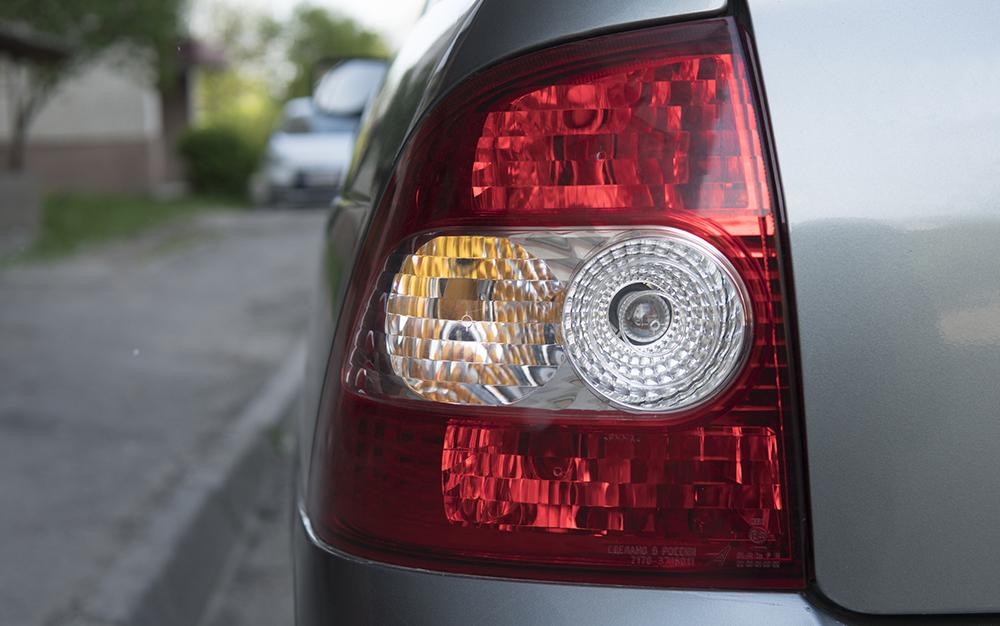
Several lights can be combined in one light, e.g. rear light and stop light.
And then there are the permitted lights and reflectors:
Additional high beam headlights - driving lights - additional stop lights - additional tail lights - additional rear lights - fog lights - reversing lights - rear fog lights - search and work lights - marker lights - parking lights - white reflectors on the front - amber reflectors on the sides - additional red reflectors on the rear - high/low beam headlights can be connected so that they can be used as overtaking indicators when you press a spring-loaded switch.
Please notethat there are special rules for permitted lights that are not mentioned here.
You need to be able to verify that:
- All lights and reflectors must be intact and clean, and all lights must be able to illuminate.
- The dipped beam must not dazzle (judged by the upper edge of the light border falling 1 cm per metre)
- The stop lights are significantly brighter than the rear lights when the brake pedal is pressed
- The indicators flash a yellow light that is clearly visible in sunlight
- All indicators can be switched on on one switch to function as hazard warning lights
- That the rear licence plate is illuminated with white light
- Lights in a pair of lights have the same colour, shape and brightness
- The horn should have a clear, constant tone
- If the indicators are flashing significantly faster than usual, this is usually a sign that one or more indicators are not working.
§ In front there must be:
- Two high beam headlights that can illuminate the road at least 100 metres in front of the car.
- Two lamps with asymmetric low beam that can illuminate the road at least 30 metres in front of the car without dazzling.
- Two lights with position light that can be clearly seen 300 metres away without glare.
- Two indicators.
§ At the back there must be:
- Two lights with rear lights that can be clearly seen 300 metres away without glare.
- Three lights with stop lights.
- At least one number plate light so that the number plate can be clearly read from a distance of at least 20 metres.
- Two indicators.
- Two red reflectors.
§ There must be two indicators at the front and rear of the vehicle and one on each side of the vehicle. Vehicles longer than 6 metres must be equipped with approved and marked amber side reflectors and side marker lamps, which must be distributed on the sides of the vehicle. Side marker lamps must be clearly visible from a distance of at least 300 metres without dazzling.
Bulbs must be correctly fitted in the headlight sockets (possibly judged from the outside by the position of the light/dark border).
On vehicles wider than 2.10 metres, there must be two front and two rear marker lamps that can be seen from a distance of at least 300 metres without glare.
Load-bearing parts
The load-bearing parts of a car are the chassis (or chassis frame), wheels (i.e. tyres, rims and wheel bearings), suspension (with axles), springs and shock absorbers.
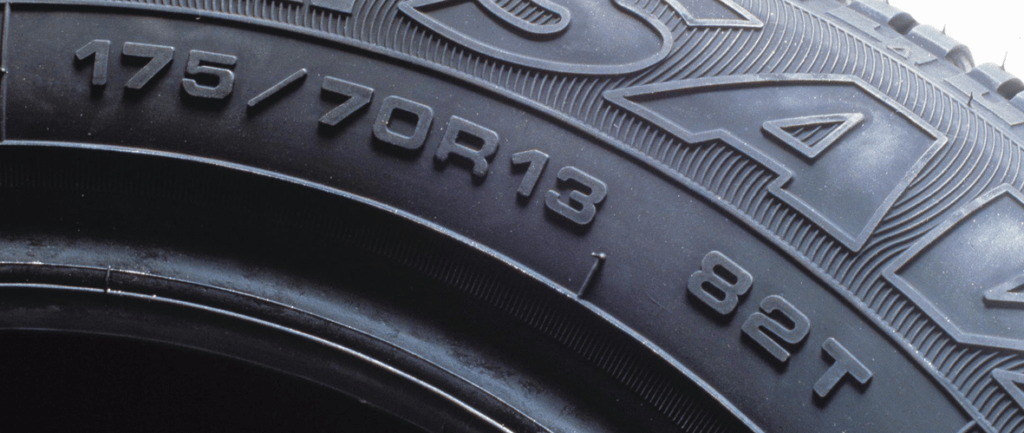
There are several types of tyres:
Radial, bias and winter/terrain tyres
(with >> M +S << labelling).There are also special emergency spare tyres.

§ The law states that:
- Tyres, wheel rims and wheel bearings must be undamaged.
- All four tyres must be of the same type (except for the emergency spare) and inflated to the air pressure specified by the manufacturer. Adjust the tyre pressure with an air pump and check with a tyre pressure gauge.
- Studded tyres can only be used from 1 November to 15 April and must be fitted on all four wheels.
- The car must have shock absorbers on all wheels.
- Abnormal noise or shaking from wheel bearings or suspension can be a sign of a fault.
Tyres and shock absorbers
You need to be able to verify that:
- The main pattern is at least 1.6 mm deep. You may be able to judge this by wear indicators.
- All four shock absorbers are in order. This means that the car immediately stops rocking after a strong impact.
- Any directional tyres must be fitted in the correct direction of rotation.
You should pay special attention to these faults in the load-bearing parts:
- For example, your tyres may be wearing unevenly or unevenly. If this happens, there may be a fault in the tyre pressure, wheel or wheel alignment, brakes or shock absorbers. These things need to be fixed as soon as possible.
- If the car pulls unevenly when you brake lightly, if it is very sensitive to crosswinds, or if you experience abnormal oversteer or understeer, this indicates that the tyre pressure is incorrect. It should be corrected immediately.
- And if the car squeaks when you drive, there may be a fault in the springs or shock absorbers.
Bodywork
The body is the "shell" of the car. This includes the roof and sides with fenders, bonnet, boot lid, doors and floor. In addition to being the "shell" of the car, the body can also be the chassis of the car. All newer cars have a self-supporting body.
The bodywork must protect the people inside the car - and must not be a danger to other road users. No sharp edges (e.g. due to rust) or car parts may protrude from the bodywork. Nor should there be anything inside the vehicle that could endanger the driver or passengers.
The doors, bonnet and boot lid must have a lock to keep them closed when you're driving. In addition, there should be a safety position so that the doors don't spring open if the lock fails.
Specialised equipment
§ The law on special equipment for cars states that the car must normally be equipped with seat belts in all seating positions. And all seat belts must be approved and undamaged.
The car must be equipped with headrests on the front seats. The windscreen must be cleanable with wipers and washes. As a general rule, the windscreen must be intact and undamaged.
The vehicle must have an interior rear-view mirror and an exterior rear-view mirror on the left side. If there is insufficient visibility to the rear, there must also be an exterior rear-view mirror on the right-hand side. The mirrors must be clean, intact and correctly adjusted.
When driving, you should carry an approved warning triangle so that you have it at hand in situations where you are required to display it.
Remember that the windscreen must be able to be kept clean. Check that you have enough washer fluid. That is, enough so that if the windscreen gets dirty, you can keep it clean with washer fluid and wipers for as long as needed.
Specialised vehicles
When it comes to the layout and equipment of other vehicles that you can drive with a category B licence (van, car and van trailer, quad bike, 3-wheel motorcycle, small and large moped, tractor and motorised implement), special rules apply. These are rules regarding the length and width of the vehicle, as well as inscriptions on the permitted load and gross vehicle weight, brakes, lights, tyres, mirrors and trailer coupling
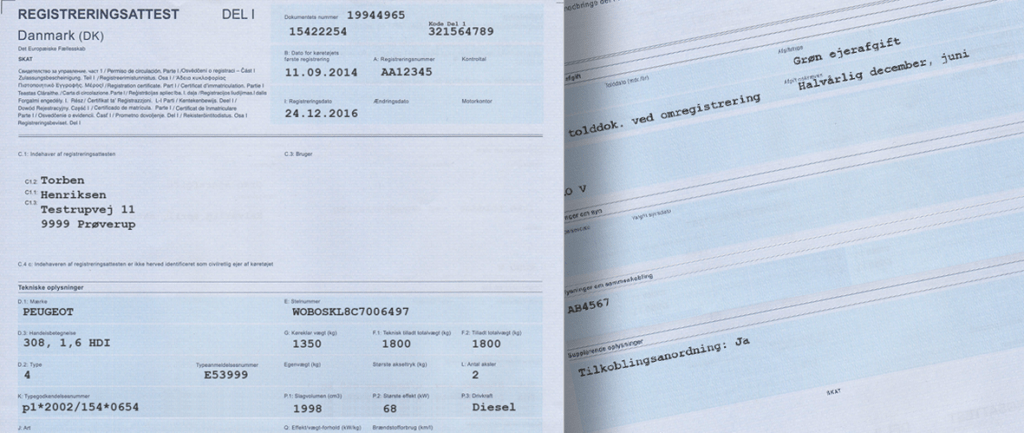
In order for a car to be used, it must be registered and a registration certificate must be issued. On the registration certificate, you can find the vehicle's unladen weight / kerb weight, its permissible total weight and, if applicable, the weight of any trailers that may be attached to it.
Based on the registration certificates, you can determine whether the car and trailer can be coupled.
§ When travelling with a trailer, the registration certificates of the car and trailer must be brought. When driving abroad, you must bring the original certificates or a copy issued by a motor vehicle registration office. When driving in Denmark, copies can be brought. Many countries require the original registration certificate to be carried when driving in these countries.
Energy and environmentally friendly driving
Energy-efficient driving isn't necessarily driving at a snail's pace, but it is calm, considered driving. For example, when approaching a light-controlled intersection, you can usually judge whether you need to stop (for a yellow or red light) or not. If you do, there's no need to approach the junction at high speed - and then slam on the brakes at the end.
Energy-efficient driving typically results in 5-10% of fuel savings and in many cases up to 25% savings. When you slow down, you can reduce fuel consumption by letting off the accelerator completely - rather than coasting.
It's also a good idea not to let the engine idle for long periods of time - it pollutes. You can simply start the engine just before you drive
Test your knowledge
Cat. B - Sections 1.1 - 1.3
Select the questions you think are the right ones.

